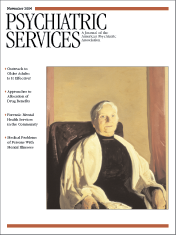Managing Transitions and Ensuring Good Care
An article in this issue describes principles of "transition management" developed by the American Association of Community Psychiatrists (AACP). Although the association's efforts are commendable, I believe that the principles do not reflect some of the realities of providing community care.
First, AACP offers little definition of "transition" beyond "moving from one level of care to another" or "a better term for discharge." Undefined, "transition" becomes a euphemism that obscures reality and promotes a false sense of complacency. Services are rarely integrated and rarely reflect rational levels of care. Making many moves rarely promotes an individual's recovery. When it's "lights out" and the ward has no more beds, what is the more accurate documentation: "Discharged to SRO" or "Transitioned to community placement"? AACP's terminology ignores the iatrogenic risks that are often associated with transitions. Clients and clinicians may prefer the word "discharge," a definite end state. Reaching this state can be empowering, less stigmatizing, and less frustrating than remaining in the limbo of unnecessary, unproductive, and often nondirectional transitions.
AACP's uncritical acceptance of a "continuum of care" overlooks reports of successful outcomes obtained by some programs that avoid the continuum and address problems in vivo. In the psychiatric emergency service in Trieste, Italy, the goal is zero admissions. When possible, Trieste's approach avoids "transitions"—no matter how conceptually elegant—along a "continuum of care," because such transitions are often unnecessary and because they unrealistically require individuals who have difficulty coping in any environment to cope in multiple settings.
"Managing transitions," as described by the AACP, focuses almost exclusively on patient-level interventions. Transitions are better understood as a function of individual and community needs as well organizational politics and convenience. Moves often reflect bureaucratic or financial considerations. Permanent housing is generally preferred over transitional housing, although the latter must often be used. In one example, a group of hospital patients, whose ultimate destination was a group home, were discharged to a halfway house, where they received daily training in living skills. Their baseline assessments, however, showed that they all possessed the target skills on the day they moved in. Because of the focus on deficits, patients were given the message that they were inadequate when, in truth, the group home stood empty because the provider organization was engaged in a political battle to acquire permission to use the home as a client residence. Involving those clients in the battle, to the extent that they were capable, might have been empowering and more helpful to their recovery. It is important to recognize the social components of transitions and incorporate them into practice.



